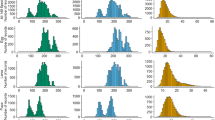Abstract
For group-living animals the choice of whether to join aggregations or initiate their own is influenced by potential benefits such as group protection and reduced energetic expenditure, as well as costs such as competition for food and mates. The bark beetle Ips grandicollis is an invasive pest species that colonises recently felled timber in Australian pine (Pinus spp.) plantations. Male beetles initiate colonies by burrowing under the bark of trees and emitting an aggregation pheromone which attracts conspecifics, including a harem of females with whom they mate. We predicted that males that initiated colonies, or who arrived early, would have larger harems than later arrivals (due to decreased competition for females). However, we found the opposite effect with early-arriving males actually associated with fewer females than later arriving males, although this may have resulted from some females leaving harems as they get older. We conclude that pioneering does not improve male likelihood of attracting females in Ips grandicollis, at least initially, but it may provide advantages for offspring when competing for food during development.


Similar content being viewed by others
References
Anderbrant O (1989) Reemergence and second brood in the bark beetle Ips typographus. Holarct Ecol 12:494–500
Bensch S, Hasselquist D (1991) Territory infidelity in the polygynous great reed warbler Acrocephalus arudinaceus: the effect of variation in territory attractiveness. J Anim Ecol 60:857–871
Byers JA (1989) Behavioral mechanisms involved in reducing competition in bark beetles. Holarct Ecol 12:466–476
Candolin U, Voigt HR (2003) Size-dependent selection on arrival times in sticklebacks: why small males arrive first. Evolution 57:862–871
Giraldeau LA, Beauchamp G (1999) Food exploitation: searching for the optimal joining policy. Trends Ecol Evol 14:102–106
Heinsohn R, Packer C (1995) Complex cooperative strategies in group-territorial African lions. Science 269:1260–1262
Kirkendall LR (1983) The evolution of mating systems in bark and ambrosia beetles (Coleoptera: Scolytidae and Platypodidae). Zool J Linn Soc 77:293–352
Lanier GN, Cameron EA (1969) Secondary sexual characteristics in the North American species of the genus Ips (Coleoptera: Scolytidae). Can Entomol 101:862–870
Latty TM, Reid ML (2009) First in line or first in time? Effects of settlement order and arrival date on reproduction of a group-living beetle, Dendroctonus ponderosae. J Anim Ecol 78:549–555
Latty TM, Magrath MJL, Symonds MRE (2009) Harem size and oviposition behaviour in a polygynous bark beetle. Ecol Entomol 34:562–568
Lawson SA, Furuta K, Katagiri K (1995) Effect of tree host and beetle density on reproduction and survival of Ips typographus japonicus Niijima (Col., Scolytidae), in Hokkaido, Japan. J Appl Entomol 119:383–390
Lindenfors P, Tullberg BS, Biuw M (2002) Phylogenetic analyses of sexual selection and sexual size dimorphism in pinnipeds. Behav Ecol Sociobiol 52:188–193
Mangel M (1990) Resource divisibility, predation and group formation. Anim Behav 39:1163–1172
Morgan FD (1967) Ips grandicollis in South Australia. Austral For 31:137–155
Pekar S, Hruskova M, Lubin Y (2005) Can solitary spiders (Araneae) cooperate in prey capture? J Anim Ecol 74:63–70
Pureswaran DS, Sullivan BT, Ayres MP (2006) Fitness consequences of pheromone production and host selection strategies in a tree-killing bark beetle (Coleoptera: Curculionidae: Scolytinae). Oecologia 148:720–728
Raffa KF (2001) Mixed messages across multiple trophic levels: the ecology of bark beetle chemical communication systems. Chemoecology 11:49–65
Raffa KF, Berryman AA (1983) The role of host plant resistance in the colonization behavior and ecology of bark beetles (Coleoptera: Scolytidae). Ecol Monogr 53:27–49
Rasbash J, Steele F, Browne W, Prosser B (2004) A user’s guide to MLwiN version 2.0. Institute of Education, London
Reid ML (1999) Monogamy in the bark beetle Ips latidens: ecological correlates of an unusual mating system. Ecol Entomol 24:89–94
Robertson IC (1998) Paternal care enhances male reproductive success in pine engraver beetles. Anim Behav 56:595–602
Robins GL, Reid ML (1997) Effects of density on the reproductive success of pine engravers—is aggregation in dead trees beneficial? Ecol Entomol 22:329–334
Sallé A, Raffa KF (2007) Interactions among intraspecific competition, emergence patterns, and host selection behaviour in Ips pini (Coleoptera: Scolytinae). Ecol Entomol 32:162–171
Schlyter F, Zhang QH (1996) Testing avian polygyny hypotheses in insects: harem size distribution and female egg gallery spacing in three Ips bark beetles. Oikos 76:57–69
Smith RJ, Moore FR (2005) Arrival timing and seasonal reproductive performance in a long-distance migratory landbird. Behav Ecol Sociobiol 57:231–239
Steed BF, Wagner MR (2004) Importance of log size on host selection and reproductive success from Ips pini (Coleoptera: Scolytidae) in ponderosa pine slash of northern Arizona and western Montana. J Econ Entomol 97:436–450
Webster MS (1992) Sexual dimorphism, mating system and body size in new world blackbirds (Icterinae). Evolution 46:1621–1641
Wood SL (1982) The bark and ambrosia beetles of North and Central America (Coleoptera: Scolytidae), a taxonomic monograph. Great Basin Nat Mem 6:1–1359
Zhang QH, Byers JA, Schlyter F (1992) Optimal attack density in the larch bark beetle, Ips cembrae (Coleoptera: Scolytidae). J Appl Ecol 29:672–678
Acknowledgements
Forestry SA allowed us access to the Wirrabara plantations. We thank Charlma Phillips (Forestry SA) for making the arrangements for us to carry out the fieldwork, and the forester Bruno Turrini for logistical assistance and his generous help and enthusiasm. Emile van Lieshout and Kath McNamara provided comments on an earlier draft of this manuscript. This research was funded by a Discovery Project Grant from the Australian Research Council, a Canadian Natural Sciences and Research Council Graduate Scholarship, and travel grants from the Department of Zoology, University of Melbourne and the Western Forest Genetics Association (Canada and USA).
Author information
Authors and Affiliations
Corresponding author
Rights and permissions
About this article
Cite this article
Symonds, M.R.E., Magrath, M.J.L. & Latty, T.M. Reproductive Consequences of Male Arrival Order in the Bark Beetle, Ips grandicollis . J Insect Behav 25, 401–407 (2012). https://doi.org/10.1007/s10905-011-9308-2
Revised:
Accepted:
Published:
Issue Date:
DOI: https://doi.org/10.1007/s10905-011-9308-2




